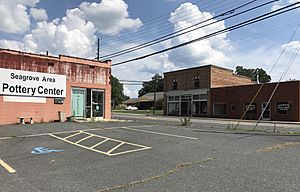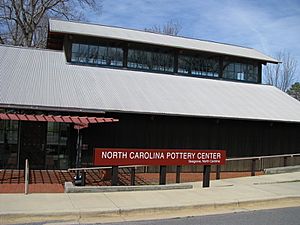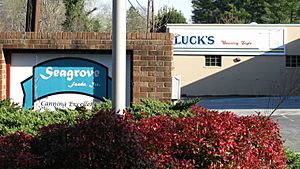Seagrove, North Carolina facts for kids
Quick facts for kids
Seagrove, North Carolina
|
|
|---|---|

Downtown Seagrove
|
|

Location of Seagrove, North Carolina
|
|
| Country | United States |
| State | North Carolina |
| County | Randolph |
| Incorporated | 1913 |
| Named for | Edwin G. Seagrove |
| Area | |
| • Total | 1.15 sq mi (2.98 km2) |
| • Land | 1.15 sq mi (2.97 km2) |
| • Water | 0.01 sq mi (0.01 km2) |
| Elevation | 722 ft (220 m) |
| Population
(2020)
|
|
| • Total | 235 |
| • Density | 205.24/sq mi (79.23/km2) |
| Time zone | UTC-5 (Eastern (EST)) |
| • Summer (DST) | UTC-4 (EDT) |
| ZIP code |
27341
|
| Area code(s) | 336 |
| FIPS code | 37-60080 |
| GNIS feature ID | 2407304 |
Seagrove is a small town in Randolph County, North Carolina, United States. In 2019, about 285 people lived there. The town got its name from a railroad official when the train tracks first came through the area.
Seagrove is famous for its pottery tradition. The name "Seagrove" often refers to the town itself and also nearby communities that are part of the "North Carolina Pottery Highway" (NC 705). More than 100 pottery shops are found in Seagrove and the towns of Robbins and Star. This area also includes small communities like Erect, Happy Hollow, Westmoore, and Whynot. Seagrove is home to the North Carolina Pottery Center, which opened in 1998. It welcomes visitors from all over the world.
Contents
History of Seagrove
Seagrove was named after Edwin G. Seagraves, a railroad official. He helped plan the train route through this area. Local stories say that the town was supposed to be named "Seagraves." However, a sign painter ran out of space and also misspelled the name, so it became "Seagrove." The railroad served Seagrove until 1951. The old train station is now a pottery museum.
The Plank Road
Construction on the Plank Road started in 1849. This road was very long, stretching about 129 miles (208 km). It was made of wooden planks, each about 8 feet (2.4 m) long and 9 to 16 inches (230 to 410 mm) wide. The planks were about 3 inches (76 mm) thick.
The Plank Road was used by people on horseback, wagons, and stagecoaches. Travelers had to pay a toll of one cent for every mile (1.6 km) for a wagon with four horses. After the railroad was built, fewer people used the Plank Road. By 1862, much of it was no longer used. Today, parts of North Carolina Highway 705 follow the old Plank Road route.
Seagrove School's Journey
A school was started in Seagrove on April 3, 1911, with money from the community. The school moved to a new location in 1918 and again in 1926. Sadly, the school building burned down on March 24, 1934, but it was rebuilt.
The Seagrove school taught students from elementary to high school until 1970. In the fall of 1970, high school students started going to the new Southwestern Randolph High School. Later, in 1990, students in grades 6 to 8 began attending Southwestern Randolph Middle School. Today, the building is called Seagrove Elementary School. It teaches students from Kindergarten to 5th grade.
Pottery in Seagrove
Seagrove has a very old pottery tradition. It started in the 1700s, even before the American Revolution. Many of the first potters in Seagrove were immigrants from Scotland and Ireland. They mostly made useful, glazed earthenware items. Because of the good quality clay found nearby and easy ways for traders to transport goods, Seagrove became well-known for its pottery.
The popularity of Seagrove pottery decreased during the Industrial Revolution. This was when new ways of preparing food became common. For a while, making containers for drinks was a good way to earn money. However, the pottery business continued to decline in the early 1900s.
In 1915, Jacques and Juliana Busbee from Raleigh tried to help the pottery industry. Over many years, the Busbees hired Seagrove potters like JH Owen, Charlie Teague, and Ben Owen. They made special pottery pieces under the name Jugtown Pottery. These were sold in their shop in Greenwich Village, NYC, and later from the Jugtown shop in Seagrove.
Around 1920, a new market appeared. Pottery became popular with tourists driving through the area. They would buy inexpensive souvenirs. This new tourist industry changed pottery from being mostly useful to being more decorative. After another decline from the 1950s to the 1970s, interest in traditional pottery grew again. In 1982, local potters started the North Carolina Museum of Traditional Pottery. They also organized the Seagrove Pottery Festival. This event happens every year the weekend before Thanksgiving in the old bean cannery.
Families like the Cole, Auman, Owen, Teague, and Albright families are eighth- and ninth-generation potters. They continue this long tradition in Seagrove.
Some of the oldest pottery places still open today include the "Original" Owens Pottery, started in 1895, and Jugtown Pottery, started in 1921. Jugtown Pottery was added to the National Register of Historic Places in 1999 because of its importance.
Pinto Beans and Luck's Cannery
Seagrove also has a history with food products. For many years, it was home to Luck's Incorporated. This company started in the 1950s as Mountain View Cannery. It was founded by Ivey B. Luck, Alfred Spencer, and H. Clay Presnell. When Spencer and Presnell sold their shares to Luck, the company became known as Luck's.
Luck's was known for its pinto beans and other canned vegetables. It provided many jobs for families in Seagrove. The Luck's plant closed in 2002 after being bought by larger companies. Today, the old plant building is used as the town's police station. It also hosts the "Celebration of Seagrove Potters" every November and other local events.
Geography and Location
According to the United States Census Bureau, the town of Seagrove covers about 0.7 square miles (1.8 km2) of land. A very small part of it is water.
The exact middle point of North Carolina's population is located about two miles east of Seagrove.
Economy and Tourism
Every year, thousands of visitors come to Seagrove to explore the area's many pottery shops. Seagrove's economy relies heavily on money brought in by tourists who come to buy pottery.
Population Facts
| Historical population | |||
|---|---|---|---|
| Census | Pop. | %± | |
| 1920 | 189 | — | |
| 1930 | 245 | 29.6% | |
| 1940 | 316 | 29.0% | |
| 1950 | 319 | 0.9% | |
| 1960 | 323 | 1.3% | |
| 1970 | 354 | 9.6% | |
| 1980 | 294 | −16.9% | |
| 1990 | 244 | −17.0% | |
| 2000 | 246 | 0.8% | |
| 2010 | 228 | −7.3% | |
| 2020 | 235 | 3.1% | |
| U.S. Decennial Census | |||
In the year 2000, there were 246 people living in Seagrove. They lived in 109 households, and 69 of these were families. The population was spread out, with about 20.7% of people under 18 years old. About 19.1% were 65 years or older. The average age in Seagrove was 41 years.
Most people in Seagrove were White (95.12%). A small percentage were African American (1.22%), Native American (0.81%), or from other races (2.85%). About 3.25% of the population was Hispanic or Latino.
The average income for a household in Seagrove was $31,250. For families, the average income was $40,750. About 9.0% of families and 9.0% of the total population lived below the poverty line. This included 13.3% of those under 18.
See also
 In Spanish: Seagrove para niños
In Spanish: Seagrove para niños



